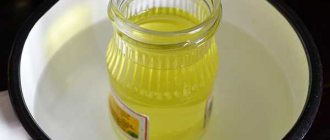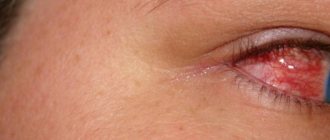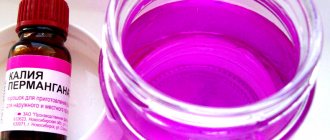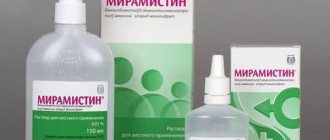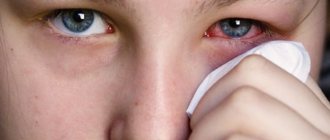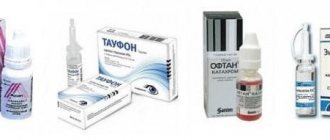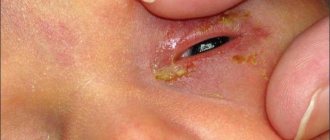Conjunctivitis is an infectious inflammation of the conjunctiva of the eyeball. This disease is often observed in children. Furacilin for conjunctivitis is the most popular medical drug.
[toc]
Scientists distinguish several types of this disease depending on the type of pathogen. But pathology can also develop as an allergic reaction to any irritant.
Which Furacilin is suitable for a child
Furacilin is produced by the manufacturer in a single form - in the form of yellow tablets that should be diluted. They will save babies from conjunctivitis and other bacterial infections. The only thing you can’t do is consume the solution internally.
If Furacilin is needed for a child, it can be bought at any pharmacy; you do not need to see a doctor for a prescription. The instructions for the medication clearly state the antibacterial properties of the product:
- the active substance relieves the symptoms of E. coli;
- used in combination with other effective medications to treat identified streptococci;
- successfully fights dysentery bacillus;
- prevents infection with other infections from a patient who is nearby.
The wide scope of application allows young mothers to rinse the eyes of their infants with the solution every day and regularly use it for inflammation in adolescents. However, sometimes there is individual intolerance to the drug, so if you notice a small rash and redness or swelling of the skin in the eye area, it is better to consult a pediatrician. Most likely, Furacilin will be canceled.
Instructions for use Furacilin tablets 20 mg
- PROMOTIONS in pharmacies
| > |
|
How to properly prepare a solution of furatsilin
For conjunctivitis in children of any age, furatsilin is very often used in treatment. Before rinsing weakened eyes, you need to prepare a solution by diluting the medication with hot water, and this must be done every time. A step-by-step guide to diluting the drug looks like this:
- Heat the water.
- Prepare a glass; it should be clean. If in doubt, it is advisable to clean its walls several times with soda.
- Place a spoon in the glass to prevent the glass from breaking when filling with hot water.
- Place 1 Furacilin tablet on the bottom and fill with liquid. 100 ml of water is enough to wash your eyes once.
- Your goal is to wait until the medication is completely dissolved, but you cannot allow the water to cool to a cold state. After a couple of minutes, crush the tablet with a spoon; the solution temperature is comfortable at room temperature.
- For some mothers, it is not customary to dilute Furacilin directly in water - first the tablet is crushed to a powder state on a clean napkin and only then mixed with water.
- If you are not sure that you can dilute the product to a homogeneous liquid, fold the gauze in several layers and strain the solution. If there are any particles, they will definitely remain on the surface of the fabric.
As a last resort, the solution can be stored for 1 day, but no more. A stale composition can aggravate the situation with conjunctivitis in children and provoke even greater inflammation of the eyes.
Washing rules - how to wash your eyes at home?
Washing with solutions is practiced when foreign bodies get into the eyes, in case of infectious diseases (conjunctivitis, blepharitis, dacryocystitis), as well as simply to relieve fatigue from the eyes after a working day. There are quite a lot of solutions for this.
Means and methods for washing will be presented for informational purposes. They can be used as part of home therapy only after examination and strictly as prescribed by an ophthalmologist.
You can wash your eyes at home using a bowl, glass, or pipette. Regardless of which method you choose, the rinsing water should not be below 15 degrees. Only in emergency cases, when time ticks by seconds, can this rule be neglected.
A bowl or plate is suitable for the procedure if a foreign body has entered the eye. The container must be deep enough. Pour the solution into it in such an amount that it does not splash out when you put your face in it.
Take a deep breath into your lungs, dip your face in the bowl, and open your eyes. It is better not to bend too low, otherwise water will get into your nose. Make movements in different directions with your eyeballs in the water. Due to this, washing will be of better quality.
Afterwards, pat your eyes dry with a clean towel.
The glass is not suitable for removing debris and other foreign bodies from the eyes. But you can cope with eye fatigue with its help. The glass should be larger in diameter than the size of the eye socket. Pour water into it with the product diluted in it, apply the edges of the glass to the eye socket and lift your head up.
The eye and bottom of the glass should be directed toward the ceiling. Some liquid will spill, but most of it should remain in the glass. Perform several circular movements with your eyeballs, blink, wait until the solution is evenly distributed throughout the mucous membrane. Repeat the procedure with the second eye.
Pipette rinsing is commonly practiced for infants' vision. A syringe will do instead. Fill a container with the solution and drop one or two drops into the child’s eye.
Remove any remaining liquid that has leaked from the eye and onto the face with a previously prepared cotton pad or bandage. After your baby closes his eye, lightly massage his eyelid. Do not touch the surface of the eyeball with the pipette.
The washing procedure may differ depending on the type of solution you use. If the liquid should not come into contact with the tissues of the eye, only the eyelids are lubricated with it.
All described manipulations are carried out only with clean hands and using sterile containers. Now we’ll find out how to wash your eyes at home, what solutions exist for this.
Eye wash at home - which product to choose?
Eyes are washed with folk remedies and medications. Some people trust only various herbs and infusions, others try to be guided solely by the recommendations of ophthalmologists.
Some are based on their own beliefs. As a rule, the following agents are used: furatsilin, chlorhexidine, saline solution, penicillin, miramistin, hydrogen peroxide, boric acid and solutions from medicinal plants - chamomile, tea, etc.
Let's consider the purpose of these drugs.
Why rinse your eyes with chlorhexidine?
Chlorhexidine is a strong antiseptic. It is often prescribed for conjunctivitis, in which purulent crusts appear. It is better not to prepare a solution based on this substance yourself, as it contains aggressive components that can damage the mucous membrane.
You can purchase a ready-made solution of chlorhexidine with a concentration of 0.02 or 0.05%. Wash the purulent eyes with the eyelids closed. You need to moisten a swab (gauze, cotton wool) in the solution and wipe it over your eyelids from the temple to the inner corner of the eye. For conjunctivitis, rinsing is done 5 or more times a day.
If the solution gets on the surface of your eye, rinse it with water.
Are eyes washed with furatsilin?
The eyes are washed with furatsilin for infectious eye diseases. This product is an antibiotic, but it is considered one of the safest. With its help, inflammatory processes are suppressed and bacteria are destroyed.
Of the home remedies, furatsilin is the most common. The solution is prepared using tablets and water. Dissolve them in a glass and let it brew for 10-15 minutes. After this, you need to strain the liquid through cheesecloth. Place a bandage (gauze bandage) in the clean solution and wipe your eyelids with it.
It is especially effective to wash purulent eyes with furatsilin. The solution easily eliminates suppuration. Therefore, it is also often used to wash the eyes for conjunctivitis.
If you have any unused solution left, put it in the refrigerator. Wait until the liquid has warmed up a bit before using it again. You can rub the bottle in your hands.
When should you wash your eyes with penicillin solution?
Penicillin belongs to a group of drugs with an antiseptic effect. It is recommended for eye pathologies that have an infectious etiology. A solution of this substance is very simple to make. Pour warm water into the penicillin bottle and shake it. After this, soak cotton wool in the liquid and wipe your eyelids.
Instead of penicillin, you can use ready-made solutions, for example, Miramistin. They are available in every pharmacy. The washing procedure is no different from those described earlier.
Do you rinse your eyes with hydrogen peroxide solutions?
Peroxide is a rather aggressive substance that, if used incorrectly, can harm the conjunctiva. Contact with the skin or surface of the eyeball causes chemical burns.
Peroxide is used to treat contact lenses. It disinfects well, destroying all types of microbes. However, after such disinfection, contact optics must be washed in a different solution!
If you do not have medications on hand - “Furacilin”, “Penicillin”, “Chlorhexidine”, “Miramistin”, you can rinse your eyes with regular saline solution. It is prepared from water and salt and helps eliminate suppuration without damaging the skin of the eyelids and eyes. It also has a drawback. Saline solution is not very effective at killing bacteria.
Boric eye wash solution
To prepare a boron-based solution, you need to dissolve it in distilled water. You can buy medicinal boric acid at a pharmacy. One teaspoon is enough for a glass of water.
Rinsing is carried out by applying lotions to closed eyelids. For each eye you need to prepare different compresses.
A boron solution is used for conjunctivitis and other diseases accompanied by inflammation and suppuration.
Now you know how to wash your eyes at home.
Listed above are drugs that are approved by specialists and are often prescribed by them. Folk remedies - decoctions and infusions of chamomile, tea - are best used in conjunction with basic medications, that is, as an additional method of treatment.
How and with what to wash your eyes in emergency situations?
If chemicals come into contact with the eyes, rinsing must be done without waiting for an ambulance to arrive. Water does not neutralize all substances, but dilutes them, reducing the degree of their effect on the tissue of the eyeball. It takes too long to prepare solutions for chemical burns.
The damaged eye is washed with tap water. The procedure is carried out until the doctor arrives. First aid for burns caused by chemicals is always carried out in this way - prolonged rinsing with water.
How to understand that treatment is not helping
Sometimes treatment of conjunctivitis in children is delayed, and the inflammatory process not only does not decrease, but even increases. This does not mean that Furacilin does not work; perhaps you need to change the course of therapy by adding a couple of potent drops, or conduct a full diagnosis of the baby’s eye condition.
Ophthalmologists note the following signs of the acute phase of conjunctivitis:
- a feeling of dryness in the mucous membrane of the affected eye;
- swelling of the skin, which in children may subside after a couple of hours;
- red tint of the mucous membrane;
- scabies, itching, tingling in the eye or eyelids;
- pain symptom;
- discharge of yellowish fluid;
- desire to cover eyelids in bright light.
At the same time, young mothers should not immediately panic if their child’s eyes are red, especially if he is in school. The loads in educational institutions today are too great for a small body, so the slightest overexertion makes itself felt. Rinse your eyes with Furacilin and put your child to bed early.
Swelling of the eyes may also be indicated by a viral infection of the “barley” type, which is treated, among other things, with Furacilin solution. Swelling of the eyelids is also observed when consuming a product to which the young patient is allergic.
There are a great many reasons for changes in the condition of the eyes, so before assuming serious diagnoses, you need to contact a highly qualified doctor who will indicate the real disease and prescribe an adequate course of therapy.
Types and symptoms of conjunctivitis
Conjunctivitis can occur in several ways. The disease may be:
Bacterial conjunctivitis is caused by harmful bacteria affecting the eyes. This type of disease tends to occur with severe symptoms - itching, burning, swelling of the conjunctiva, clouding of the cornea, photophobia, lacrimation. In many cases, purulent discharge from the eyes appears.
The viral form of the disorder manifests itself against the background of acute respiratory viral infections, colds, and is most often associated with damage to the body by adenovirus. The pathology is characterized by the above-mentioned clinical picture, however, unlike bacterial conjunctivitis, this type of disease can resolve on its own.
With the fungal variety of the disease, mold or yeast fungi are activated. The main manifestations of the pathology include symptoms in the form of separation of clear fluid from the sclera, the formation of purulent vesicles and fistulas. This variant of the disease is rare and has the longest course.
The occurrence of allergic conjunctivitis is preceded by contact with allergens (household chemicals, animal hair or dander, pollen, perfumes, dust). In this case, typical symptoms are supplemented by coughing, sneezing, and a rash on the skin.
How to prevent re-infection
If Furacilin helped and conjunctivitis was cured, you can be congratulated. But let’s not forget about preventive measures that will help maintain health for a long period of time:
- Children have a habit of scratching and touching their eyes while playing on the playground or walking with their parents. Explain to your child about the bacteria that inhabit our vast planet and why eye soreness may reoccur.
- Give your baby her own towel. The need to adhere to the rules of personal hygiene has not yet been canceled.
- You shouldn’t wipe away a child’s tears from the wind or frost with a handkerchief - they often use it to clean their hands and nose, which are far from sterile and clean. Take dry disposable wipes with you out into the street, arranged in separate packages.
Preparing the solution
A solution prepared from Furacilin is used to disinfect the organs of vision. To prepare the medicinal composition, you must proceed as follows:
- Wash your hands thoroughly with soap and dry them with a clean towel.
- Grind 2 tablets of the drug (0.02 mg each) to a powder.
- Pour the resulting mixture into a clean ceramic container.
- Pour two cups of boiling water.
- Stir thoroughly.
- Leave the product on for 30-40 minutes.
When the composition has cooled to the optimal temperature, it is filtered using sterile gauze or a bandage, preventing small particles from entering the liquid.
It is not recommended to store the resulting product. Before each procedure, a fresh solution should be prepared using filtered water.
Side effects and contraindications
Most often, eye rinsing with Furacilin is tolerated without complications. If the recommended proportions were exceeded during the preparation of the solution, the risk of the following increases:
- dizziness;
- nausea;
- dyspeptic disorders;
- skin reactions.
In particularly severe cases, there is a possibility of developing optic neuritis.
It is prohibited to use a solution with Furacilin to wash the eyes if the patient suffers from the following disorders:
- various types of bleeding;
- dermatological pathologies;
- helminth infection of the skin;
- demodicosis;
- allergic reactions.
The drug is contraindicated if nitrofural is poorly tolerated or if there are serious problems with the urinary system. Increased caution requires the use of the solution in people with reduced filtration and excretory renal function.
The solution can be used during pregnancy and lactation only after doctor's approval.
Precautionary measures
You should know! During treatment with Furacilin, several important rules should be followed:
- Wash your hands thoroughly before the procedure .
- Wipe each eye with a clean cotton pad or gauze swab and do not use the hygiene product twice.
- Do not take the drug orally .
- Avoid rinsing your eyes with stale solution .
- Instruments for manipulation should be sterilized and treated with an antiseptic.
- After treatment, do not put a blindfold on your eyes , as this helps to activate pathogenic bacteria.
- Do not go outside for .
